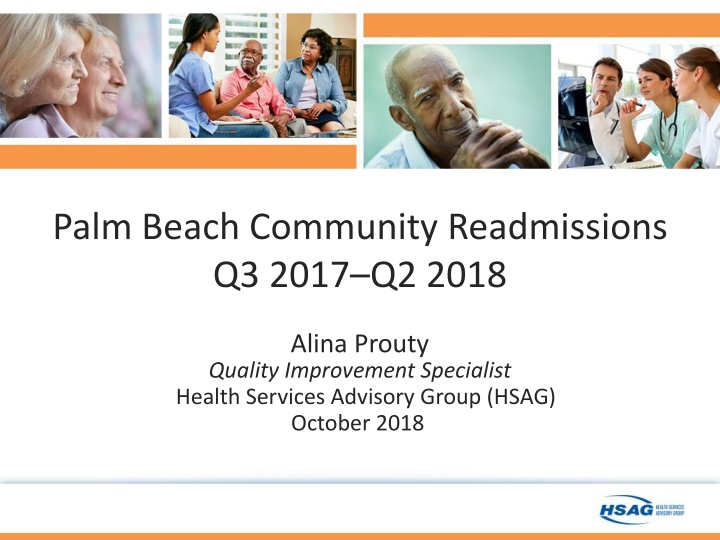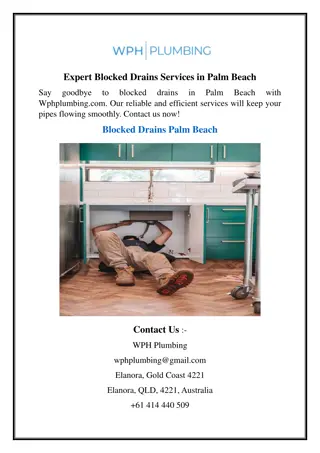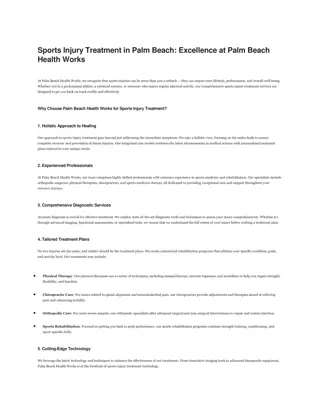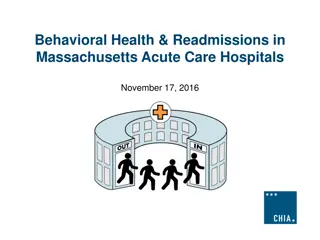Analysis of Palm Beach Community Readmissions Q3 2017-Q2 2018
This analysis conducted by Alina Prouty, a Quality Improvement Specialist at Health Services Advisory Group (HSAG), focuses on readmissions in Palm Beach Community between Q3 2017 and Q2 2018. It includes data on community population, 30-day readmissions, sources of readmissions within seven days of hospital discharge, the correlation between seven-day readmissions and high-risk medications (HRMs), and patients on HRMs by drug category. The analysis sheds light on key insights related to readmission patterns and high-risk medication use in the community.
Uploaded on Sep 22, 2024 | 1 Views
Download Presentation

Please find below an Image/Link to download the presentation.
The content on the website is provided AS IS for your information and personal use only. It may not be sold, licensed, or shared on other websites without obtaining consent from the author.If you encounter any issues during the download, it is possible that the publisher has removed the file from their server.
You are allowed to download the files provided on this website for personal or commercial use, subject to the condition that they are used lawfully. All files are the property of their respective owners.
The content on the website is provided AS IS for your information and personal use only. It may not be sold, licensed, or shared on other websites without obtaining consent from the author.
E N D
Presentation Transcript
Palm Beach Community Readmissions Q3 2017 Q2 2018 Alina Prouty Quality Improvement Specialist Health Services Advisory Group (HSAG) October 2018
Community Population and Readmissions 216 909 6,277 34,885 185,515 Palm Beach Community The Complete Standard Analytical Tables (CSAT) data file [Part A claims for Fee-For-Service (FFS) beneficiaries] was used for this analysis for the time period 07/01/17 06/30/18. 2
30-Day Readmissions by Volume Q3 2017 Q2 2018 6 2 5 4 1 7 3 1,809 in days 1 3 1,890 in days 4 7 554 38% 685 486 Week one 722 464 4 146 414 12 212 Other*: Other*: 11 12 14 10 13 8 9 2,420 in days 8 14 25% Week two 915 Other: 12 156 575 762 19 21 20 17 18 15 16 19% 1,901 in days 15 21 Week three 668 589 6 Other: 466 172 24 25 26 28 27 23 22 19% 1,841 in days 22 30 Week four Other*: 412 611 7 142 669 29 *Other: long-term acute care (LTAC), rehab facilities, psych facilities, critical access hospitals (CAHs), and left against medical advice (AMA). 30 = Home = Skilled Nursing Facility (SNF) = Home Health Agency(HHA) = Hospice The CSAT data file (Part A claims for FFS beneficiaries) was used for this analysis for the time period 07/01/17 06/30/18. 3
Source of Readmissions Within Seven Days of Hospital Discharge 3,699 occurred within seven days of hospital discharge. 38 percent had been discharged to home without home health agency (HHA). 24% (878) Home HHA 10% (358) 0.4% (16) Hospice 38% (1,407) Other 28% (1,040) SNF The CSAT data file (Part A claims for FFS beneficiaries) was used for this analysis for the time period 07/01/17 06/30/18. 4
Seven-Day Readmissions and High-Risk Medications (HRMs) Of the 2,834 patients readmitted within seven days of hospital discharge, 1,275 patients were on HRMs. That is approximately two out of every five people. The CSAT data file (Part A claims for FFS beneficiaries) and the Medicare Part D date file were used for this analysis for the time period 07/01/17 06/30/18. 5
Seven-Day Readmissions and HRMs Patients on HRMs: Drug Category # of Readmissions % of Readmissions Opioids only 232 408 18% 32% 20% Anticoagulants only 257 Hypoglycemia only 9% 7% 10% Opioids + Anticoagulants 118 83 129 48 Opioids + Hypoglycemia Anticoagulants + Hypoglycemia 4% Opioids + Anticoagulants + Hypoglycemia The CSAT data file (Part A claims for FFS beneficiaries) and the Medicare Part D date file were used for this analysis for the time period 07/01/17 06/30/18. 6
Medication-Related Readmissions Most post-discharge adverse drug events(ADEs) are related to medications. The odds of being hospitalized for ADEs are four to seven times higher in older adults. Medication management is an evidence- based, proven strategy to improve medication safety. 1 . 7x 2 MTM 1. Greenwald JL, Denham CR, Jack BW. The hospital discharge: a review of a high risk care transition with highlights of a reengineered discharge process. J Patient Saf. 2007;3:97-106. 2. Salvi F, Marchetti A, D Angelo F, et al. Adverse drug events as a cause of hospitalization in older adults. Drug Saf. 2012; 35 (Suppl 1):29-45. 7
Medication Interventions Medication reconciliation: Comparison of all new and current medications a patient is taking Medication therapy management: Comprehensive review of all patient medications to ensure optimal outcomes Chart review: Retrospective or real-time review Medication screening project: Screening tools to identify discrepancies 8
Next Steps HSAG invites providers to use the ADE Data Collection Tool to: Screen patients who are taking HRMs. Identify ADEs. Determine interventions. 9
Thank you Alina Prouty Quality Improvement Specialist AProuty@hsag.com Office: 813.865.3185 Cell: 813.546.7748
This material was prepared by Health Services Advisory Group, Inc., the Quality Improvement Organization for Florida under contract with the Centers for Medicare & Medicaid Services (CMS), an agency of the U.S. Department of Health and Human Services. The contents presented do not necessarily reflect CMS policy. Publication No. FL-11SOW-C.3-11302018-11























